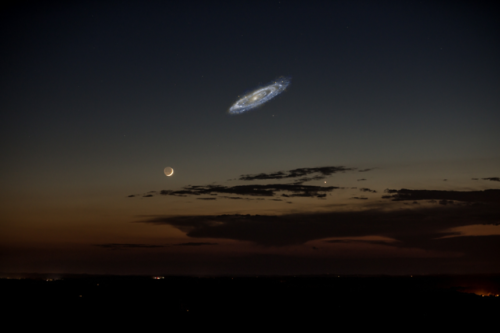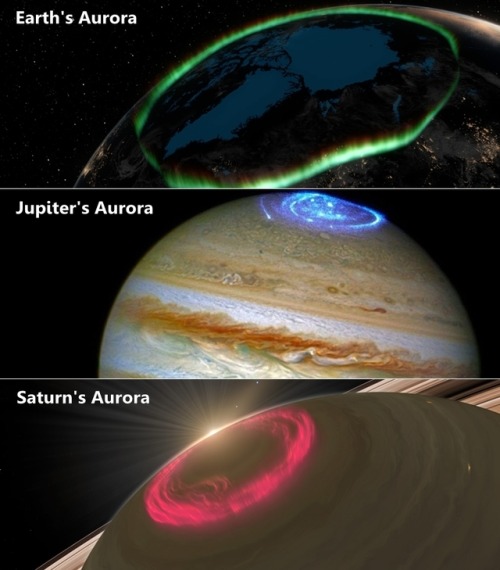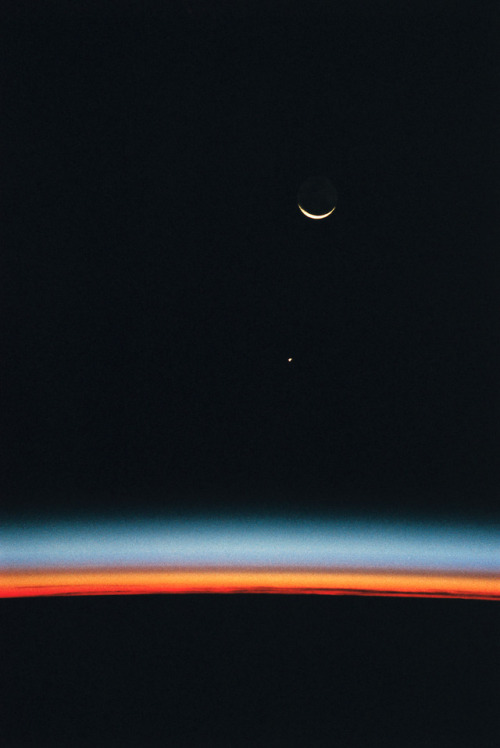This Image Shows Something Spectacular: A Massive Galaxy Cluster That It Is Warping The Space Around

This image shows something spectacular: a massive galaxy cluster that it is warping the space around it! The cluster, whose heart is at the centre of the frame, is named RCS2 J2327, and is one of the most massive clusters known at its distance or beyond.
Massive objects such as RCS2 J2327 have such a strong influence on their surroundings that they visibly warp the space around them. This effect is known as gravitational lensing. In this way, they cause the light from more distant objects to be bent, distorted, and magnified, allowing us to see galaxies that would otherwise be far too distant to detect.
Credit: ESO, ESA/Hubble & NASA
More Posts from Riekod and Others

Leidenfrost drops – liquid drops that levitate on a layer of their own vapor over a hot surface – have been all the rage in recent years. We’ve seen how they can be guided, trapped, and self-propelled. What you see here is a bit different. This is a droplet of room-temperature ethanol deposited on a bath of liquid nitrogen. What levitates the droplet in this case is vaporous nitrogen evaporating from the bath.
The droplet is quickly cooling down; it freezes after its second or third bounce off the side walls of the beaker. What causes the droplet to self-propel is an asymmetry of the thin vapor layer beneath the droplet. As soon as some instability causes a slight difference in the thickness of the vapor layer, that triggers the propulsion, which the drop maintains even after freezing. (Image and research credit: A. Gauthier et al.)



Andromeda’s actual size if it was brighter
via reddit

Our planet seen from Saturn, captured by the Cassini spacecraft
Image credit: NASA

Artistic conception of the auroras os Saturn and Earth (jupiter’s image is real - ultraviolet) Instagram: wonders_of_the_cosmos
“The most exciting phrase to hear in science, the one that heralds new discoveries, is not ‘Eureka!’ (I’ve found it!), but ‘That’s funny…’”
— Isaac Asimov | Author - I, Robot | Professor - Biochemistry

This scene, captured with a 35mm camera from inside the Space Shuttle Endeavour, shows Jupiter rising above the airglow over Earth’s horizon. The crescent Moon is at top frame.
Credit: NASA
Free Astronomy Resources
Astronomy
Astronomy Lecture Powerpoints
Astronomy Lecture Notes (Textbook-Like)
Astronomy Notes
Astronomy Lecture Notes (Alaska)
Astronomy Lecture Powerpoints (Trinity)
Astronomy Lecture Notes (MIRA)
Astronomy Lecture Powerpoints (Rutten)
Modern Astronomy Lecture Notes
Astronomy Lecture Powerpoints (Wickman)
Solar System Astronomy Lecture Notes
Astronomy Lecture Notes
Astronomy Lecture Notes (Mitchell)
Astronomy Lecture Notes (Rochester)
Time Systems Lecture Notes
Earth and Sky Notes
Galactic Structure and Stellar Populations Lecture Notes
Stars, Galaxies, and the Universe Lecture Notes
Astronomical Techniques
Essential Radio Astronomy
Introduction to Astronomy
Physics
Equations and Formulas
Essential Physics Equations
MCAT Physics Equations
Frequently Used Physics Equations
General Physics Notes
Physics Lecture Notes (MIT)
University Physics (Textbook-Like)
General Physics I
Physics Lecture Notes (Colorado)
Physics Lecture Notes (Rochester)
Physics Lecture Notes (Cabrillo)
Physics Lecture Notes (Trinity)
Physics Notes
Physics Videos (Flipping Physics)
Physics Ch 1 to 8 Lecture Notes
Feynman Physics Lecture Notes
Electromagnetism
Electromagnetism Lecture Notes
Feynman Electromagnetism and Matter Lecture Notes
Mechanics
Mechanics (Physics) Lecture Notes
Mechanics (Physics) Powerpoint Slides
Feynman Quantum Mechanics Lecture Notes
Physics and Astronomy
Physics of the Interstellar Medium Lecture Notes
Physics for Astronomy Lecture Notes (Textbook-Like)
Radio Astronomy (Physics 728)
Physics: Astronomy, Astrophysics, and Cosmology
Inorganic Chemistry
Inorganic Chemistry Chapter Notes
Inorganic Chemistry Lecture Notes
Inorganic Chemistry 2 Lecture Notes
Advanced Inorganic Chemistry Lecture Notes
Calculus
Formulas and Equations
Calculus Cheat Sheet
AP Calculus Basic Formulas and Properties
Calculus 1 Formulas
Basic Calculus: Rules and Formulas (Video)
Differential Formulas
Integral Calculus Formulas
The Basics
Basic Calculus Refresher
Single Variable Calculus
Multivariable Calculus (Textbook-like)
Basics of Calculus (Textbook-like)
Calculus for Beginners
Calculus 1
Calculus (Textbook-like)
Calculus 1 (Textbook-like)
Calculus 1 Video Lectures
Calculus 1 Lecture Notes
Calculus 1 Lecture Notes (Northern Illinois)
Calculus 1 Lecture Notes (Citadel)
Calculus 1 Compact Lecture Notes
Calculus Lecture Notes (Raz Kupferman)
Introduction to Calculus Lecture Notes
Calculus 2
Calculus 2 Lecture Notes
Calculus 2 Lecture Notes (Northern Illinois)
Calculus 2 Notes (Illinois State)
Calculus 2 Lecture Notes (McClendon)
Calculus 2 Lecture Notes (Textbook-like)
Calculus 2 (Textbook-like) (Dawkins)
Calculus 2 Lecture Videos
Calculus 2 Class Notes
Calculus 2 Materials (Notes, Handouts, Etc.)
Calculus 3
Calculus 3 Lecture Notes (Lamar)
Calculus 3 Lecture Videos
Calculus 3 (Dawkins)
Calculus 3 (Notes, Homework, Quizzes)
Notes for Calculus 3
Calculus 3 Class Notes
Other Calculus
Integral Calculus Lecture Notes
Algebra and Differential Calculus
Differential and Integral Calculus (Textbook)
Differential and Integral Calculus (Lecture Notes & Old Exams)
Computer Science Calculus Lecture Notes
Calculus for Physics C
Analytic Geometry and Calculus 2
History
Notes on the History of Astronomy
History of Astronomy Powerpoint
Early History of Astronomy
History of Radio Astronomy
NASA History
Neolithic Astronomy
Mesopotamian Astronomy
Islamic Astronomy
Indian Astronomy
Greek Astronomy
Chinese Astronomy
Egyptian Astronomy
Mayan Astronomy
Space Agencies
National Aeronautics and Space Administration
South African National Space Agency
Canadian Space Agency
National Space Research and Development Agency
Italian Space Agency
Norwegian Space Center
Korea Aerospace Research Institute
Japan Aerospace Exploration Agency
UK Space Agency
Australian Space Agency
Tools of the Trade: How Parker Solar Probe Will Study the Sun
Our Parker Solar Probe will get closer to the Sun than any spacecraft has ever gone – it will fly right through the Sun’s corona, part of the Sun’s atmosphere.

This spacecraft is full of cutting-edge technology, from its heat shield down to its guidance and control systems. It also carries four suites of advanced instruments designed to study the Sun in a multitude of ways.
1. Measuring particles
Two of Parker Solar Probe’s instrument suites are focused on measuring particles – electrons and ions – within the corona.
One of these particle-measuring instrument suites is SWEAP (Solar Wind Electrons Alphas and Protons). SWEAP counts the most common particles in the solar wind – the Sun’s constant outflow of material – and measures their properties, like velocity, density and temperature. Gathering this information about solar wind particles will help scientists better understand why the solar wind reaches supersonic speeds and exactly which part of the Sun the particles come from.

One instrument in the SWEAP suite is the Solar Probe Cup. Most of the instruments on Parker Solar Probe stay safe and cool in the shadow of the heat shield, but the Solar Probe Cup is one of the few that sticks out. That’s so it can capture and measure particles streaming straight out from the Sun, and it had to go through some intense testing to get ready for this position in the Sun’s incredibly hot corona.

Credit: Levi Hutmacher/Michigan Engineering
The ISʘIS suite (pronounced EE-sis, and including the symbol for the Sun in its acronym) also measures particles. ISʘIS is short for Integrated Science Investigation of the Sun, and this instrument suite measures particles that move faster – and therefore have more energy – than the solar wind.
These measurements will help scientists understand these particles’ lifecycles – where they came from, how they got to be traveling so fast (these particles can reach speeds more than half the speed of light!) and what path they take as they travel away from the Sun and into interplanetary space.

2. Taking pictures – but not of the Sun’s surface.
WISPR (Wide-Field Imager for Parker Solar Probe) has the only two cameras on Parker Solar Probe – but they’re not pointed directly at the Sun. Instead, WISPR looks out the side of the spacecraft, in the direction it’s traveling, looking at the space Parker Solar Probe is about to fly through. From that vantage point, WISPR captures images of structures within the corona like coronal mass ejections, or CMEs. CMEs are clouds of solar material that occasionally explode from the Sun at millions of miles per hour. Because this solar material is magnetized, CMEs can trigger geomagnetic storms when they reach Earth – which, in turn, can cause effects like auroras and even, in extreme cases, power outages.

Right now, our observations of events like these come from satellites orbiting near Earth, so WISPR will give us a whole new perspective. And, scientists will be able to combine WISPR’s images with Parker Solar Probe’s direct particle measurements to get a better idea of how these structures change as they travel.

3. Studying electric & magnetic fields
The FIELDS instrument suite is appropriately named: It’s what scientists will use to study the electric and magnetic fields in the corona.
Electric and magnetic fields are key to understanding what happens, not only on the Sun, but throughout space, because they are the primary driver accelerating charged particles. In particular, a process called magnetic reconnection – when magnetic field lines explosively realign, sending particles rocketing away at incredible speeds – is thought to drive solar explosions, as well as space weather effects on Earth, like the aurora.

FIELDS measures electric and magnetic field at high time resolution, meaning it takes lots of measurements in a short amount of time, to track these processes and shed some light on the mechanics underlying the Sun’s behavior. FIELDS’ measurements are precisely synced up with those of the SWEAP suite (one of the sets of instruments studying particles) so that scientists can match up the immediate effects that electric and magnetic fields have on the material of the solar wind.

Parker Solar Probe launches summer 2018 on its mission to study the Sun. Keep up with the latest on the mission at nasa.gov/solarprobe or follow us on Twitter and Facebook.
Make sure to follow us on Tumblr for your regular dose of space: http://nasa.tumblr.com.
-
 cutesisterinlaw liked this · 6 years ago
cutesisterinlaw liked this · 6 years ago -
 unseenontv reblogged this · 6 years ago
unseenontv reblogged this · 6 years ago -
 bass-wily reblogged this · 6 years ago
bass-wily reblogged this · 6 years ago -
 moondrunkdog reblogged this · 6 years ago
moondrunkdog reblogged this · 6 years ago -
 murdockparkour reblogged this · 6 years ago
murdockparkour reblogged this · 6 years ago -
 knifeflips reblogged this · 6 years ago
knifeflips reblogged this · 6 years ago -
 chameleonkid liked this · 6 years ago
chameleonkid liked this · 6 years ago -
 perspectiv8 reblogged this · 6 years ago
perspectiv8 reblogged this · 6 years ago -
 opheliawithrosesinherlungs liked this · 6 years ago
opheliawithrosesinherlungs liked this · 6 years ago -
 marigoldmonsoon reblogged this · 6 years ago
marigoldmonsoon reblogged this · 6 years ago -
 belldebubs reblogged this · 6 years ago
belldebubs reblogged this · 6 years ago -
 unicornglitternutellacookie liked this · 6 years ago
unicornglitternutellacookie liked this · 6 years ago -
 shakeoffyourflesh reblogged this · 6 years ago
shakeoffyourflesh reblogged this · 6 years ago -
 five0fswords liked this · 6 years ago
five0fswords liked this · 6 years ago -
 hekkso reblogged this · 6 years ago
hekkso reblogged this · 6 years ago -
 copernican-void reblogged this · 6 years ago
copernican-void reblogged this · 6 years ago -
 i-am-chidorixblossom liked this · 6 years ago
i-am-chidorixblossom liked this · 6 years ago -
 lickrock reblogged this · 6 years ago
lickrock reblogged this · 6 years ago -
 lutefisk-kingdom reblogged this · 6 years ago
lutefisk-kingdom reblogged this · 6 years ago -
 somegoodsheith reblogged this · 6 years ago
somegoodsheith reblogged this · 6 years ago -
 somegoodsheith liked this · 6 years ago
somegoodsheith liked this · 6 years ago -
 the17thmuse liked this · 6 years ago
the17thmuse liked this · 6 years ago -
 the-study-of-fandoms liked this · 6 years ago
the-study-of-fandoms liked this · 6 years ago -
 frscotty-blog liked this · 6 years ago
frscotty-blog liked this · 6 years ago -
 vivisect8 reblogged this · 6 years ago
vivisect8 reblogged this · 6 years ago -
 vivisect8 liked this · 6 years ago
vivisect8 liked this · 6 years ago -
 indianswiftiesstuff liked this · 6 years ago
indianswiftiesstuff liked this · 6 years ago -
 dopearies reblogged this · 6 years ago
dopearies reblogged this · 6 years ago -
 angeljules reblogged this · 6 years ago
angeljules reblogged this · 6 years ago -
 cacklingstump liked this · 6 years ago
cacklingstump liked this · 6 years ago -
 queerdelights8 reblogged this · 6 years ago
queerdelights8 reblogged this · 6 years ago -
 queerdelights8 liked this · 6 years ago
queerdelights8 liked this · 6 years ago -
 heichoukirkland liked this · 6 years ago
heichoukirkland liked this · 6 years ago -
 coolcoolcoolperalta reblogged this · 6 years ago
coolcoolcoolperalta reblogged this · 6 years ago -
 xkiinji liked this · 6 years ago
xkiinji liked this · 6 years ago -
 fosteringcuriosity-blog1 reblogged this · 6 years ago
fosteringcuriosity-blog1 reblogged this · 6 years ago -
 fosteringcuriosity-blog1 liked this · 6 years ago
fosteringcuriosity-blog1 liked this · 6 years ago -
 policromico reblogged this · 6 years ago
policromico reblogged this · 6 years ago -
 hiperbole reblogged this · 6 years ago
hiperbole reblogged this · 6 years ago -
 ka1ium reblogged this · 6 years ago
ka1ium reblogged this · 6 years ago